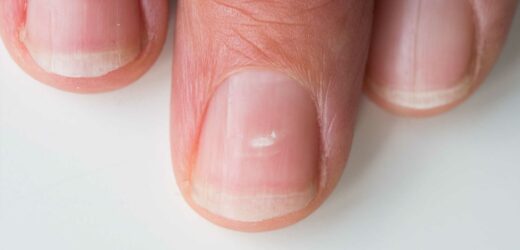A DERMATOLOGIST has revealed the signs in your nails that mean you could be suffering a sinister condition.
Dr Andrea Suarez, an internet skin expert sensation from the US, warned of nine problems, including brittle, fragile and slow-growing nails.
These can be an “early clue” of thyroid disease – when the thyroid, a gland that produces hormones, is either underactive (hypothyroidism) or overactive (hyperthyroidism).
It can cause a whole host of symptoms depending on which form a person has, such as either losing weight unintentionally, or struggling to get it off.
Other signs of the relatively common condition include being sensitive to the cold or heat, tiredness, mood swings and difficulty sleeping.
It’s important to get these conditions diagnosed because they can lead to further problems, such as with pregnancy, the heart and vision.
Read more on symptoms
I’m a nutritionist – here’s 5 things your SMILE can tell you about your health
The ‘Covid’ symptoms that could actually be sign of devastating disease
Dr Andrea said in her YouTube video: “I wanted to share this video with you all because untreated thyroid disease is deadly.
“It starts out with things like feeling lethargic or feeling jittery, depending on what the nature of the underlying thyroid problem is.
“But I want to emphasise that the nail findings I'm sharing with you, they’re not specific for a problem with the thyroid.
"So if you have these, don’t automatically jump to the conclusion that you have a problem with your thyroid.”
Most read in Health
Millions of Brits will get new Omicron-busting Covid booster jabs in WEEKS
Why do I have to urgently rush to the toilet every morning?
NHS cancer test FINALLY rolled out to more people in win for Dame Debs' campaign
I'm a nutritionist – here's 5 things your SMILE can tell you about your health
1. Spoon nails
Koilonychia, or so-called “spoon nails” is when the nail quite literally looks like a spoon.
Dr Andrea said: “This is a type of dystrophy in which the nail plate is depressed centrally and elevated laterally so it literally looks like a little spoon.
“One way to assess for this is to look at the nail and take a little drop of water and place it on the nail plate.
“If you have spoon nails that droplet of water will actually stay on the nail plate whereas if you don't it'll fall off to the sides.”
Koilonychia, which is more often seen with overactive thyroid, isn’t specific to thyroid disease.
It can happen with psoriasis, iron deficiency anaemia and diabetes, for example.
So it is worth seeing your doctor regardless.
2. Brittle nails
It won’t be hard to find someone who complains of having brittle nails – so could it be a sign of a thyroid disorder?
Dr Andrea said: “Twenty-two per cent of cases of brittle nails associated with thyroid disease were seen in people with autoimmune thyroid problems whereas 14 per cent were seen in those with non-autoimmune thyroid disease.”
Brittle nails are more common in underactive thyroid because there is “decreased blood flow to the fingertips”.
3. Fragile nails
Dr Andrea said the most common nail finding of an underactive thyroid is fragile nails.
“That makes sense again, because the blood vessels are probably clamping down in an effort to preserve core body temperature you're not getting,” she said.
“Fragility of the nail plate is probably the most common finding and hypothyroidism [underactive thyroid] reported in 70 per cent of cases.”
The symptoms of thyroid disease
Symptoms of an underactive thyroid may develop slowly, so you may not notice them for years.
According to the NHS, you should see your GP if you've been suffering from any of the below:
- tiredness
- weight gain
- depression
- being sensitive to the cold
- dry skin and hair
- muscle aches
An overactive thyroid can cause a wide range of symptoms, including:
- nervousness, anxiety and irritability
- mood swings
- difficulty sleeping
- persistent tiredness and weakness
- sensitivity to heat
- swelling in your neck from an enlarged thyroid gland (goitre)
- an irregular and/or unusually fast heart rate (palpitations)
- twitching or trembling
- weight loss
4. Slow growth
With an underactive thyroid, slow growth is also a common feature as a result of fragility.
Dr Andrea said: “Normally the nails grow roughly three and a half millimetres a month which is the equivalent of about a tenth of a millimetre a day.
“But in hypothyroidism [underactive thyroid] it's much much slower.
“So if you notice that your nails are really brittle and growing very slowly that may be a clue that your thyroid hormone is low.”
She explained that with an underactive thyroid, the body is trying harder to preserve heat, and it does so by reducing blood flow to the extremities.
This is why patients with this condition often complain of having cold hands or feet.
“As you can imagine with decreased blood flow to the extremities, you're not going to have optimal delivery of nutrients and oxygen necessary to support healthy nail growth,” Dr Andrea said.
5. Crumbling nails
Dr Andrea said: “The second most common finding in hyperthyroidism [overactive thyroid] is actually softening of the nail plate – kind of crumbly nails.
“In hyperthyroidism nail growth is usually normal or increased [called monocolysis].”
Dr Andrea said because the nails are softer they are “more vulnerable to lifting up off the underlying supportive structures”.
6. Lifting
Another “really common finding across the board” of thyroid issues is onycholysis.
Dr Andrea said: “Onycholysis refers to a separation of the nail plate from the underlying structures and as it lifts up, air gets underneath.
“The nail plate looks like a big white smear, a big white spot.”
It starts off at the tip of the nail but can expand towards the cuticle.
Lifting may be more common in those with an overactive thyroid as a result of excess sweating, Dr Andrea noted.
7. White spots
White spots or lines are medically known as leukonychia and are a rare feature of an underactive thyroid.
However, Dr Andrea says white spots can be a result of pregnancy, psoriasis, and it could just be the result of a bad manicure.
8. Pitting
Pitting is the term for dents in the nail, ranging from the size of a needle pin to a crayon tip.
As well as rarely being a symptom of an underactive thyroid, it is also seen in alopecia, eczema and psoriasis.
“But if you're noticing these nail changes again, bring it to the attention of your healthcare provider,” Dr Andrea said.
9. Clubbing
An uncommon feature of an overactive thyroid is fingernail clubbing.
It occurs in about one per cent of people with Grave’s disease – the leading cause of an overactive thyroid.
“The reason this happens is that patients who have Graves disease, which is an autoimmune disease, make anti-thyroid antibodies.
“Those antibodies actually can bind to keratinocytes, endothelial cells, fat cells, causing them to make more hyaluronic acid and other glycosaminoglycans.
“That leads to swelling of the tissues around the nail and what appears as clubbing.”
Read More on The Sun
My house is plagued by influencers taking SELFIES – it’s costing me thousands
You’ve been painting your nails wrong – a hair clip stops polish getting messy
Nail or finger clubbing can be the result of many conditions, like cystic fibrosis, heart disease, Crohn's, other cancers – or is hereditary.
But lung cancer is responsible for about 80 to 90 per cent of finger clubbing cases.
Source: Read Full Article













